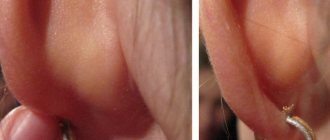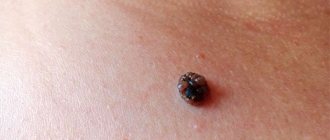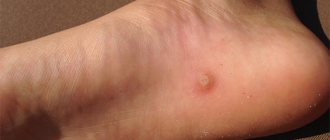Every person can have from a few to several dozen moles on their body. This phenomenon is not dangerous and does not require medical intervention. Except for those cases when nevi change their color, size, structure and cause physical pain to a person. If one of these symptoms occurs, you need to find out which doctor to see for your moles.
Causes of moles
Some moles are congenital. They are formed in connection with local disturbances in the division of skin cells during the period of intrauterine development of the fetus, and appear as the child grows. The location and size of some nevi can be inherited.
The main factor that provokes the appearance of new moles is prolonged and intense exposure to ultraviolet rays. The formation of nevi is also often observed during hormonal changes (puberty, pregnancy).
What the doctor can prescribe
Self-medication is dangerous! Therapy against warty growths should include a set of measures that act in different directions. Medicine has not learned to completely cure the disease, but it has the knowledge of how to stop the virus and send the pathogen into a dormant state that is not dangerous to health. Doctors act in two ways - they act on the pathogen from the inside and outside.
Treatment
The main reason for the appearance of papillomas is low immunity and the body’s inability to fight back against viral attacks. The patient requires help in the form of antiviral agents and immunomodulators.
Antiviral – suppress the activity of the virus. At the same time, inflammation and growth of the tumor-like process are eliminated. A number of modern drugs have a stimulating effect on the immune system, helping the body recover and protect itself.
Immunomodulators are prescribed by a doctor! They are required in extreme cases, when an immunogram has shown that a person cannot suppress the enemy on his own and correction is required.
For external effects on the affected area, a specialist can prescribe ointments, creams that increase local immunity, relieve inflammation, pain, reduce and completely eliminate papillomas. The drug is selected by the doctor, according to the research results.
Symptoms of degeneration
Doctors have identified the main signs that may indicate malignant degeneration of moles. These include:
- Rapid increase in size. One of the alarming symptoms is asymmetrical growth, which leads to a change in the shape of the nevus.
- Change in color, namely rapid and uneven darkening of the mole.
- The appearance of pain, burning at the site of localization of the formation.
- The appearance of ulcerations and cracks on the surface of the mole.
- Changes in surrounding tissues in the form of a swollen reddish corolla.
If you detect at least one of these signs, you should immediately consult a doctor. Within a short time, an ordinary mole can degenerate into a malignant skin tumor - melanoma. This tumor metastasizes quickly and has high mortality rates.
The location of a mole on areas of the skin that are constantly exposed to ultraviolet radiation (face, hands) is also a reason to consult a doctor. Intense exposure to sunlight is one of the main triggers for malignant degeneration.
In what cases should you consult a doctor?
Nevi are benign formations on the skin that do not cause harm to the human body. However, some of them can eventually develop into a malignant tumor. To prevent this, you need to monitor your moles and if any problems arise, consult a doctor. He will examine you and, if necessary, refer you for further examination.
Some symptoms should be cause for concern. To make it easier to remember them, doctors came up with a special abbreviation - AKORD . Each letter of this abbreviation means a sign that is worth paying attention to. Let's look at its decoding.
- A – asymmetry. A normal, healthy mole should have a symmetrical shape. To determine this, draw an imaginary dividing line in the middle of the nevus and see if both halves of the birthmark are symmetrical. If a mole begins to deform and change shape, you need to show it to a doctor.
- K – edge. The edges of a healthy nevus should be completely even, smooth and free of jagged edges and protrusions. If you notice that the edges of your mole have become blurred or uneven, it is worth paying attention to this.
- O – color. Normally, nevi have a uniform color - dark brown, light brown, red, beige, etc. When they degenerate into a malignant formation, the color may change - become darker or lighter. Black spots may also appear in the mole. All this should alert you.
- R – size. Moles come in different sizes. There are large formations that look quite scary, but do not pose any danger. And there are small nevi that degenerate into oncology. Normally, the size of a nevus should not change throughout life. If you notice that a mole is growing, you should not delay contacting a doctor.
- D – dynamics. This includes various changes that occur in the nevus. For example, cracks appear on its surface or hair loss is observed. The formation may thicken, begin to hurt, itch, or bleed. Sometimes no visible changes occur, but a person suddenly begins to feel his birthmark, to feel some kind of tension in this area. Any of these symptoms should be a reason to visit your doctor.
If a mole becomes inflamed or you notice at least one of the listed signs, you should not hope that everything will go away on its own. Try to show the mole to a specialist as soon as possible. Perhaps pathological processes are already occurring in it, and it is important to identify them in time in order to begin treatment.
Injury to nevi
Another factor that can trigger the onset of malignancy is trauma to the mole. Moreover, the formation can be injured either over a long period of time, for example, due to constant friction or squeezing by clothing, or as a result of a more serious external influence, for example, when a mole is cut.
If a mole is accidentally damaged, it must be thoroughly treated with a disinfectant solution. If bleeding occurs, it should be stopped using a sterile bandage or gauze. The injured formation should be examined by a doctor as soon as possible in order to determine a further course of action. The specialist may recommend removing the remaining part of the mole or undergoing routine examinations for malignancy over a period of time.
Who to contact for growths in children
Children and adults are susceptible to infection with the HPV virus. Infection occurs during childbirth, when pregnancy provokes the growth of condylomas on the external genitalia or by taking a nipple with HPV viruses into the mouth during feeding. There are many options for pathogen penetration into the body, but it is always expressed in one thing - rashes on the body or mucous membranes.
If there are few elements, the sizes are small, you can be treated by a dermatologist. He will prescribe antiviral local or systemic treatment, and perform removal with laser, radio waves or electrocoagulation.
If the growths have reached large sizes and cover a large area, you need to get rid of them with the help of a surgeon or immunologist.
In adolescence, papillomas can appear in the intimate places of girls and boys who have begun to be sexually active. Treatment is provided by a venereologist, gynecologist, and urologist. The doctor will prescribe treatment, conduct research, and provide advice on safe sex.
Which doctor should I contact about a mole?
There are several medical specialties that treat nevi: dermatologist, oncologist, surgeon. There is also a separate doctor for skin tumors - an oncodermatologist.
Visit to the dermatologist
A dermatologist is the first doctor you should contact about a mole. It is this specialist who, in most cases, is able to exclude a malignant process based on the results of examination and dermatoscopy.
Why go to a surgeon?
If the mole turns out to be benign, but is constantly subjected to friction or pressure, then it can be removed by a surgeon. You can contact a plastic surgeon if you have an aesthetic problem such as a mole on the face or other visible areas of the skin. For such nevi, if they do not raise questions regarding their benignity, laser removal is recommended.
When should you contact an oncologist?
If you have a mole with signs of malignant degeneration, you can immediately contact an oncologist. A doctor in this specialty has the necessary knowledge and skills for the surgical treatment of melanoma and other malignant skin tumors. The earlier cancer is detected, the more favorable the future prognosis will be.
Can the problem be solved by a cosmetologist?
Removal of moles in beauty salons and offices is possible only by a cosmetologist who has a higher medical education. There are several ways to remove a benign formation on the skin: laser method, cryodestruction, electrocoagulation. The patient needs to consult an oncologist before having the nevus removed by a cosmetologist, since, for example, after laser removal the possibility of histological examination of the tissue is lost.
Oncologist-mammologist
Women who have moles on the skin of the breast with signs of a possible malignant process should be examined by a breast oncologist. A doctor in this specialty selects a treatment plan taking into account the characteristics of the structure and functioning of the mammary glands.
Consultations with a dermatologist and surgeon
Pigment formations do not harm health, but only up to a certain point, until one of them begins to change color, shape, size. Having discovered such deviations, you need to find out their cause. But not everyone knows which doctor to go to for moles.
Birthmarks or nevi can be congenital or acquired. Their color varies from light yellow to black or red.
Recently, malignant tumors are appearing more and more often. An insidious consequence of the degeneration of benign moles is melanoma - skin cancer. Oncological disease develops from small nevi, within which cell transformation has occurred. To prevent the development of a malignant process, a thorough diagnosis is necessary.
The patient should know which doctor deals with moles on the body. First you need to see a dermatologist. The main procedure is dermatoscopy: the structure of the growth is examined and its nature is determined - papilloma or birthmark. After the examination, the doctor will decide whether to remove or treat the pigmented formation.
Dermatoscopy makes it possible to identify the disease and prevent pathological processes. Using a microscope, you can examine the deep layers of the epidermis.
If the birthmark does not threaten melanoma, the specialist recommends monitoring the formation. If new changes appear, you need to visit the doctor again.
If a dangerous growth is identified, the patient is advised to consult other specialists. Which doctor to go to with a mole depends on the variability of the nevus.
For example, if a mole is constantly exposed to trauma, the patient is referred to a surgeon who removes nevi. The specialist also treats vascular birthmarks (hemangiomas) in children and, if necessary, removes them.
Many people with problems with moles resort to the help of cosmetologists rather than medical institutions. However, only specialists with appropriate training should treat serious skin diseases and remove stains.
In modern medicine there are many different effective ways to remove growths. Depending on the nature of the changes in the mole, it is possible to use laser surgery or excision of the formation using a scalpel.
Diagnostics
In the process of diagnosing nevi, the doctor uses both standard methods (history collection, visual examination) and instrumental diagnostic methods. In this case, studies such as dermatoscopy, biopsy and histological analysis of the mole are highly informative.
Dermatoscopy
The essence of the dermatoscopy method is to examine the skin under magnification. During the examination, the doctor evaluates the color and structure of the epidermis, identifies the main characteristics of skin rashes, examines the epidermal-dermal junction and the papillary layer of the dermis.
To perform the study, a special device is used - a dermatoscope. This device may resemble a small magnifying glass (manual dermatoscopy) or be a special device that can be equipped with a digital photography function with the possibility of subsequent detailed, even computerized, analysis of various skin structures.
The dermatoscopy method is simple and accessible, but at the same time very informative. Examination of moles by a doctor using a dermatoscope significantly increases the chance of detecting malignant skin tumors, primarily melanoma.
Inflammation of a mole on the face
If a mole on the face is inflamed, it can be lubricated with zinc or salicylic ointment. You must be careful when using alcohol tinctures and vinegar. The skin on the face is very sensitive, so there is a risk of burns. Before treating a growth on the face with traditional methods, a doctor’s consultation and specialist information on what to do if a mole becomes inflamed are required. Malignant growths are removed surgically, which can leave a scar or scar on the face. This can ruin a person's appearance. You may be wondering how to get rid of a scar on your face after mole removal.
Self-examination of moles
Doctors recommend conducting an independent examination of moles once a month, recording their slightest changes. The inspection should be carried out in a well-lit room with a large mirror. It is necessary to have a ruler, a small mirror and a notebook on hand to record the results. First you need to undress and examine the body for the presence of moles and age spots. It is recommended to pay special attention to the feet, chest and groin areas, as well as the armpits and scalp. When a mole is detected, it is measured using a ruler and its location, size, appearance and date of examination are recorded in a notebook. Then, a month later, a re-examination is carried out for the presence of dangerous nevi.
Note! In 40% of women, melanoma develops on the lower extremities, and in 50% of men it develops on the torso.











